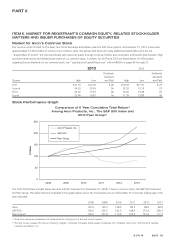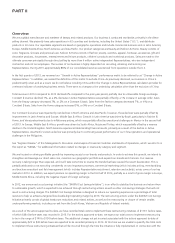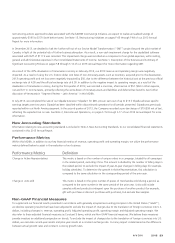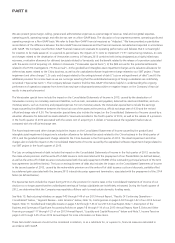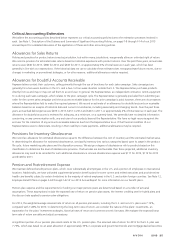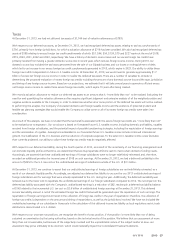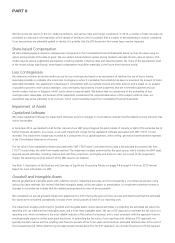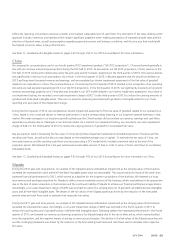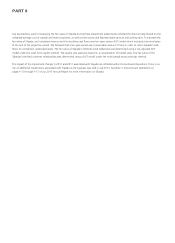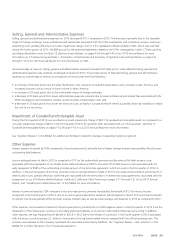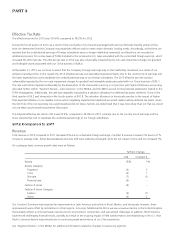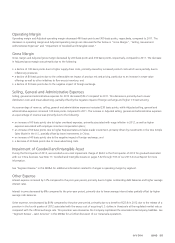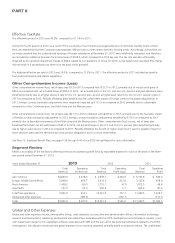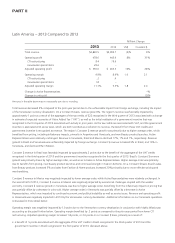Avon 2013 Annual Report Download - page 37
Download and view the complete annual report
Please find page 37 of the 2013 Avon annual report below. You can navigate through the pages in the report by either clicking on the pages listed below, or by using the keyword search tool below to find specific information within the annual report.
before the reporting unit achieves what we consider a normalized, sustainable level of cash flows. The estimation of fair value utilizing a DCF
approach includes numerous uncertainties which require significant judgment when making assumptions of expected growth rates and the
selection of discount rates, as well as assumptions regarding general economic and business conditions, and the structure that would yield
the highest economic value, among other factors.
See Note 17, Goodwill and Intangible Assets on pages F-52 through F-53 of our 2013 Annual Report for more information.
China
As compared to our projections used in our fourth quarter 2012 impairment analysis (“Q4 2012 projections”), China performed generally in
line with our revenue and earnings projections during the first half of 2013. As assumed in our Q4 2012 projections, China’s revenue in the
first half of 2013 continued to deteriorate versus the prior-year period; however, beginning in the third quarter of 2013, this revenue decline
was significantly in excess of our assumptions. As a result, in the third quarter of 2013, it became apparent that we would not achieve our
2013 and long-term forecasted revenue and earnings, and we completed an interim impairment assessment of the fair value of goodwill
related to our operations in China. The revenue decline in China during the third quarter of 2013 resulted in the recognition of an operating
loss while we had expected operating profit in our Q4 2012 projections. In the third quarter of 2013, we significantly lowered our long-term
revenue and earnings projections for China that was included in our DCF model utilized in our interim impairment assessment. As a result of
our impairment testing, we recorded a non-cash impairment charge of $42.1 in the third quarter of 2013 to reduce the carrying amounts of
goodwill and finite-lived intangible assets. There are no amounts remaining associated with goodwill or intangible assets for our China
reporting unit as a result of this impairment charge.
During the third quarter of 2012, we completed an interim impairment assessment of the fair value of goodwill related to our operations in
China, based on the continued decline in revenue performance in and a corresponding lowering of our long-term growth estimates in that
market. We made changes to our long-term growth estimates as the China business did not achieve our revenue, earnings and cash flows
expectations primarily due to challenges in our business model. As a result of our impairment testing, we recorded a non-cash impairment
charge of $44.0 in the third quarter of 2012 to reduce the carrying amount of goodwill to its estimated fair value.
Key assumptions used in measuring the fair value of China during these impairment assessments included projections of revenue and the
resulting cash flows, as well as the discount rate (based on the weighted-average cost of capital). To estimate the fair value of China, we
forecasted revenue and the resulting cash flows over ten years using a DCF model which included a terminal value at the end of the
projection period. We believed that a ten-year period was a reasonable amount of time in order to return China’s cash flows to normalized,
sustainable levels.
See Note 17, Goodwill and Intangible Assets on pages F-52 through F-53 of our 2013 Annual Report for more information on China.
Silpada
During the 2012 year-end close process, our analysis of the Silpada business indicated an impairment as the carrying value of the business
exceeded the estimated fair value and the finite-lived intangible assets were not recoverable. This was primarily the result of the lower than
expected financial performance for 2012, which served as a baseline for the long-term projections of the business. We lowered our long-
term revenue and earnings projections for Silpada to reflect a more moderate recovery of the business, which was believed to be appropriate
due to the lack of sales momentum in the business and the continued inability of Silpada to achieve our financial performance expectations.
Accordingly, a non-cash impairment charge of $209 was recorded to reduce the carrying amounts of goodwill, an indefinite-lived intangible
asset, and a finite-lived intangible asset. The decline in the fair values of the Silpada assets was driven by the reduction in the forecasted
growth rates and cash flows used to estimate their respective fair values.
During the 2011 year-end close process, our analysis of the Silpada business indicated an impairment as the carrying value of the business
exceeded the estimated fair value. Accordingly, a non-cash impairment charge of $263 was recorded in the fourth quarter of 2011 to
reduce the carrying amounts of goodwill and an indefinite-lived intangible asset. Following weaker than expected performance in the fourth
quarter of 2011, we lowered our revenue and earnings projections for Silpada largely due to the rise in silver prices, which nearly doubled
since the acquisition, and the negative impact of pricing on revenues and margins. The decline in the fair values of the Silpada reporting unit
and the underlying trademark was driven by the reduction in the forecasted growth rates and cash flows used to estimate their respective
fair value.
A V O N 2013 29


